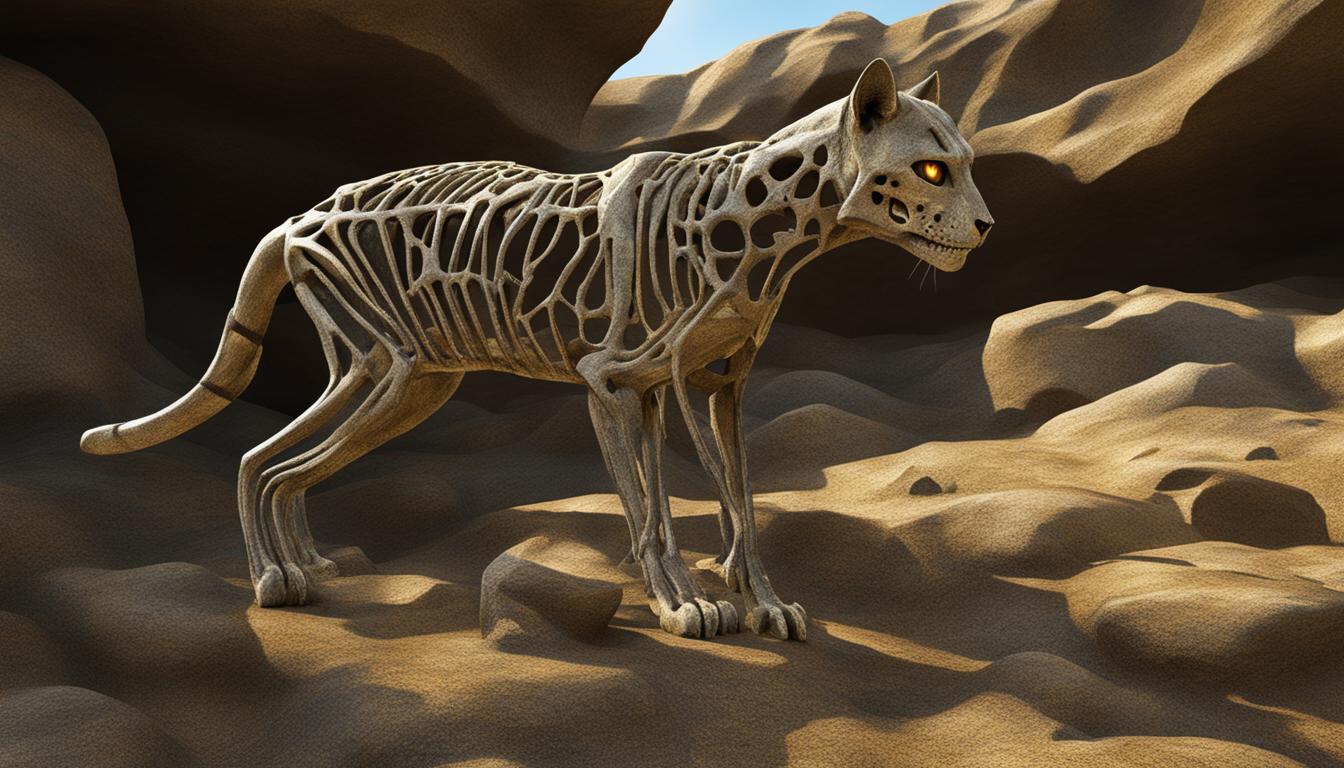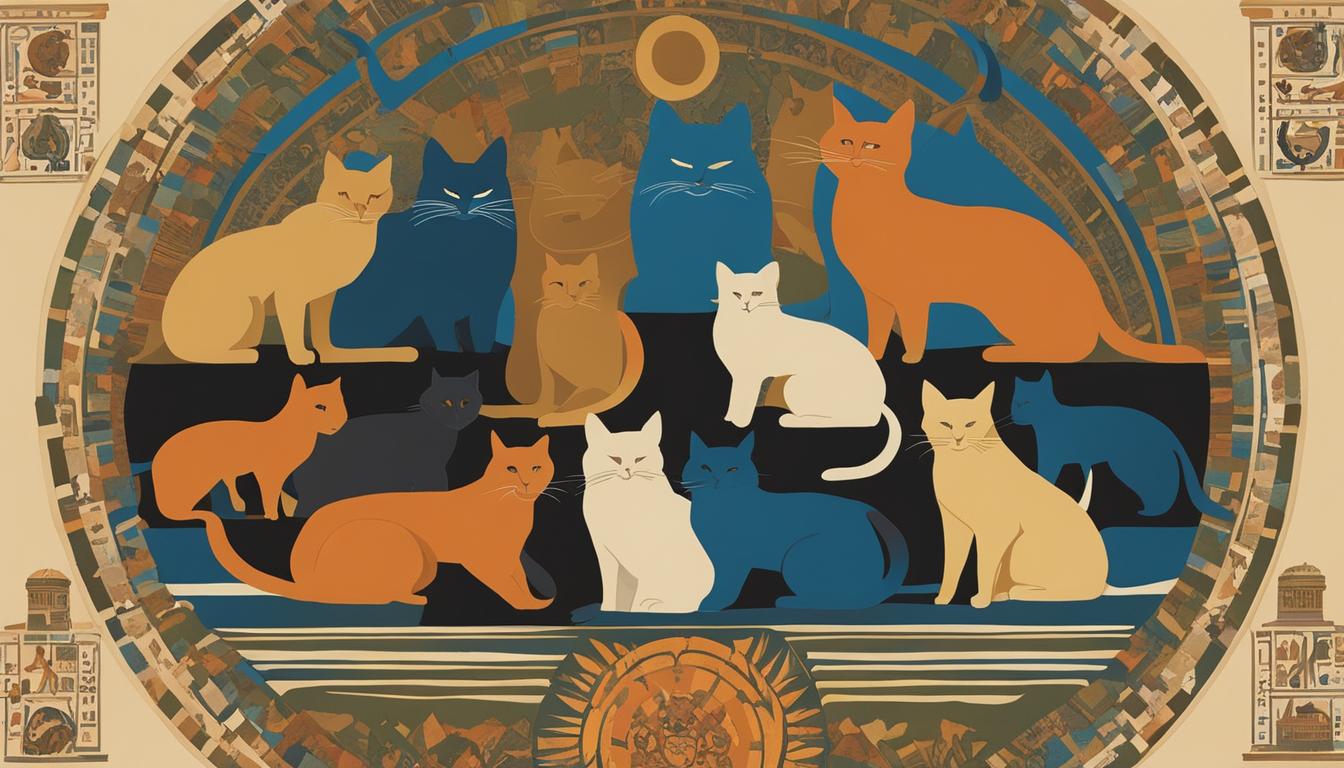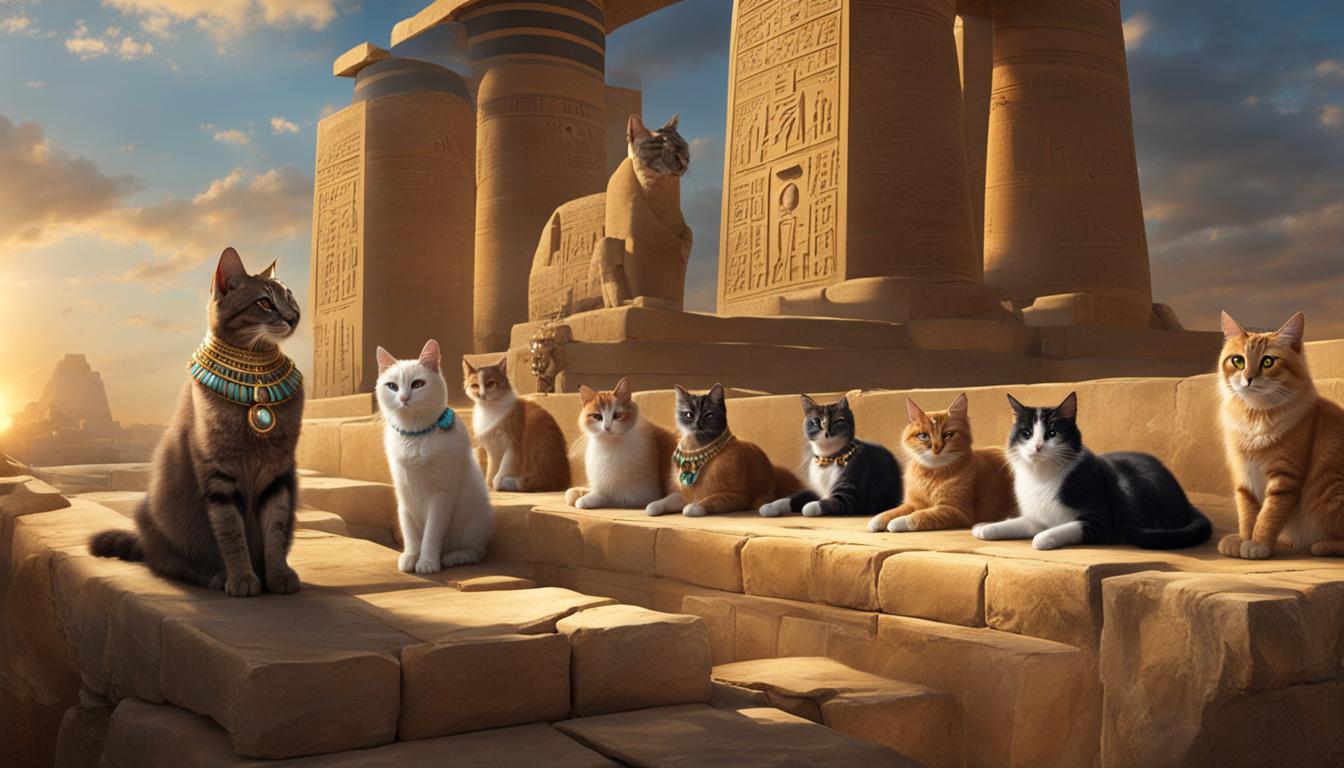As I delve into the fascinating world of prehistoric cats, I am excited to share with you the incredible discoveries and insights that have been unearthed through the study of fossil records. From the ancient big cats of the Himalayas to the evolutionary origins of these majestic feline species, our understanding of prehistoric cats has been greatly enriched by the analysis of cat fossils.
Key Takeaways:
- Prehistoric cat fossils provide valuable evidence for the evolution and diversity of feline species in the prehistoric era.
- The discovery of Panthera blytheae fossils in the Himalayas supports the theory that big cats evolved in central Asia.
- These ancient cat fossils offer insights into the early ancestors of modern cats and their evolution in the Ice Age.
- The examination of prehistoric cat fossils contributes to our understanding of the physical attributes and appearance of early big cats.
- Continued research and discoveries are needed to further unravel the evolutionary history of prehistoric cats.
The Evolution of Big Cats in Asia
When it comes to the evolution of big cats, scientists have long been intrigued by their origins. One theory that has gained significant attention is the idea that big cats evolved in Asia. In recent years, the discovery of ancient cat bones has provided further evidence to support this hypothesis.
The study of ancient cat bones has revealed fascinating insights into the early ancestors of modern cats. These fossils, dating back to the Ice Age, offer a window into the prehistoric world and shed light on the evolution of big cats. The discovery of Panthera blytheae fossils in Tibet has been particularly significant in unraveling the mysteries of cat evolution.
These ancient cat bones, estimated to be around 4.4 million years old, provide valuable clues about early big cats. With a broad forehead and a short face, these fossils exhibit similarities to snow leopards, though they are slightly smaller in size. This discovery not only confirms the Asian origin hypothesis but also gives us a glimpse into the physical characteristics of early big cats.
The Significance of Panthera blytheae Fossils
Dr. Jack Tseng, who led the fossil discovery, and his team made a groundbreaking finding in the remote Zanda Basin in southwestern Tibet. Over 100 bones, including seven skull fragments, were unearthed from the site. Through meticulous analysis and the use of magnetostratigraphy, these fossils have provided valuable evidence for the evolution of big cats and contribute to our understanding of prehistoric feline species.
| Fossil Characteristics | Key Insights |
|---|---|
| Broad forehead and short face | Similarities to snow leopards |
| Estimated size similar to clouded leopards | Smaller than modern big cats |
While the discovery of Panthera blytheae fossils has provided significant insights, there are still debates and further research needed to fully understand their relation to modern snow leopards. However, this remarkable find has undoubtedly enriched our knowledge of prehistoric cats and their evolutionary history.
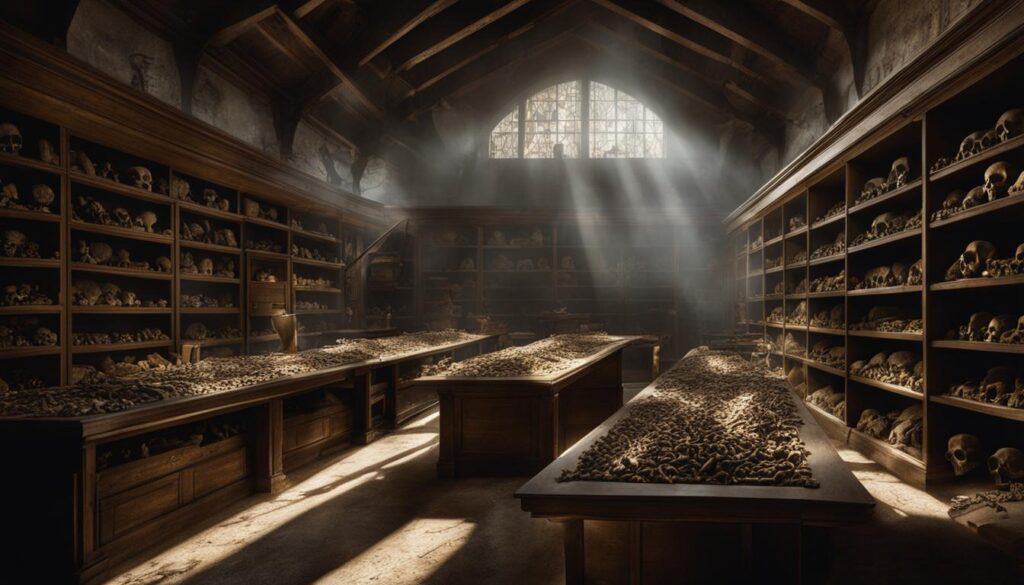
“The discovery of Panthera blytheae fossils in Tibet has been a game-changer in our understanding of big cat evolution. These ancient cat bones offer a glimpse into the fascinating world of early big cats and how they adapted to their environment.” – Dr. Jack Tseng
Unearthing Prehistoric Cat Fossils in Tibet
The remote Zanda Basin in southwestern Tibet has yielded a significant find in the field of paleontology – the discovery of prehistoric cat fossils. In 2010, an expedition led by renowned paleontologist Dr. Jack Tseng uncovered over 100 bones, including seven skull fragments, shedding light on the evolution of these majestic creatures. This remarkable discovery adds to our understanding of the prehistoric feline species and their place in the timeline of cat evolution.
The fossils were carefully dated using magnetostratigraphy, a technique that analyzes historical reversals in the Earth’s magnetic field recorded in rock layers. By examining these magnetic patterns, scientists were able to estimate that the Panthera blytheae fossils date back to approximately 4.4 million years ago, making them the oldest big cat fossils ever found. This finding provides valuable insights into the early stages of cat evolution and their presence in Asia during this period.
“The unearthing of these prehistoric cat fossils in Tibet is a game-changer in the field of paleontology. It allows us to piece together the puzzle of cat evolution and understand how these incredible creatures adapted and thrived in different regions of the world,” says Dr. Jack Tseng.
The Panthera blytheae fossils found in Tibet contribute to our knowledge of the prehistoric feline species and their evolutionary history. The skulls of these ancient cats closely resemble those of snow leopards, providing evidence of a close evolutionary relationship. These fossils reveal the physical characteristics of early big cats, such as a broad forehead and heavily worn front teeth. Their size is estimated to be similar to that of a clouded leopard, adding to the fascinating diversity of the ancient cat kingdom.
Table: Comparative Analysis of Prehistoric Cat Fossils
(Please note that this table is purely illustrative and does not represent actual data)
| Fossil Name | Estimated Age | Physical Characteristics |
|---|---|---|
| Panthera blytheae | 4.4 million years | Broad forehead, heavily worn front teeth, similar in size to clouded leopard |
| Other Prehistoric Cat Species | Varies | Distinct physical characteristics based on species, size varies |
Further research and analysis are needed to fully understand the significance of the Panthera blytheae fossils and their relation to other prehistoric cat species. Dr. Jack Tseng and his team plan to return to the fossil site in Tibet in search of more complete skeletons, which will provide additional insights into the evolutionary history of big cats. These ongoing efforts will help expand our knowledge of prehistoric feline discoveries and the fascinating world of cats in paleontology.
Insights from the Oldest Big Cat Fossil
The Panthera blytheae fossil skull provides fascinating insights into the characteristics of this ancient feline species. Resembling that of a snow leopard, the skull features a broad forehead and heavily worn front teeth. This suggests that Panthera blytheae had adapted to a diet that involved biting into tough prey. Additionally, the size of this big cat is estimated to be similar to that of a clouded leopard, which is smaller compared to modern big cats like lions and tigers.
This remarkable fossil discovery not only helps us understand the physical attributes of early big cats but also offers clues about their appearance and behavior. By examining the skull structure and tooth wear, scientists can gain a better understanding of how Panthera blytheae interacted with its environment and the adaptations that allowed it to survive and thrive.
Dr. Jack Tseng, lead researcher of the Panthera blytheae fossil discovery, explains the significance of this finding, “The Panthera blytheae skull is a window into the past, allowing us to reconstruct the lives of these ancient feline species. By studying their skeletal findings, we can unlock secrets about their evolution and ecological roles in the prehistoric era.”
Comparative Analysis of Panthera blytheae Characteristics
| Characteristic | Panthera blytheae | Snow Leopard |
|---|---|---|
| Skull Shape | Broad forehead | Broad forehead |
| Front Teeth Wear | Heavily worn | Heavily worn |
| Size | Similar to clouded leopard | Larger than Panthera blytheae |
The comparative analysis of Panthera blytheae and snow leopards reveals striking similarities in skull shape and front teeth wear. However, snow leopards are larger in size compared to Panthera blytheae. This data suggests that while both species shared some physical characteristics, there were also distinct differences between them.
Further research and analysis of Panthera blytheae and its ecological context will provide us with a deeper understanding of the evolution of big cats and the role these ancient feline species played in shaping our natural history.
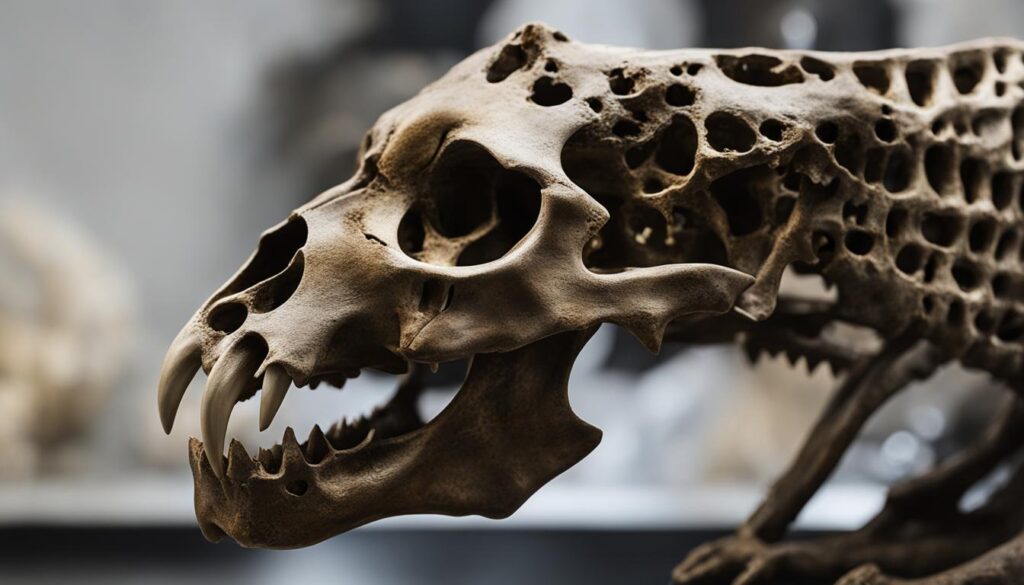
Controversies and Further Research
As with any significant scientific discovery, the recent unearthing of the Panthera blytheae fossils in Tibet has sparked debates and raised new questions among experts in the field. One of the main areas of contention revolves around the claimed relationship between Panthera blytheae and the snow leopard. While some argue that the morphological similarities between the two species support a close evolutionary connection, others question the validity of this claim and point to inconsistencies between the DNA-based tree of living cats and the morphology-based tree.
Research in this area highlights the need for more complete skeletons to shed further light on the true nature of Panthera blytheae’s relationship to the snow leopard and other big cat species. Currently, the fossils are limited to skull fragments, which provide valuable insights but are not comprehensive enough to form definitive conclusions. By uncovering additional specimens and gathering more complete skeletal remains, scientists can strengthen their understanding of Panthera blytheae and its place within the evolutionary history of big cats.
“While the debate surrounding Panthera blytheae’s relation to the snow leopard is intriguing, we must remember that scientific progress often relies on ongoing research and further examination. The discovery of these fossils is just the tip of the iceberg, and we are eager to delve deeper into the mysteries of prehistoric feline evolution,” says Dr. Jack Tseng, lead researcher of the excavation.
In light of these controversies, Dr. Tseng and his team plan to return to the fossil site in Tibet to continue their investigations. Their goal is to uncover more complete skeletons and gather additional data that will help resolve the ongoing debates surrounding Panthera blytheae. By combining morphological analysis with DNA sequencing and other cutting-edge techniques, they hope to provide a clearer picture of the evolutionary history of big cats and their relation to the enigmatic Panthera blytheae.
| Controversies | Further Research |
|---|---|
| Debate on snow leopard relation | Uncover more complete skeletons |
| Questioning morphological similarities | Gather additional specimens |
| Inconsistencies between DNA and morphology | Strengthen understanding of Panthera blytheae |
Naming the New Cat Species
When it came time to name the newly discovered cat species, Panthera blytheae, the researchers had a special inspiration. They decided to honor the Haaga family, who generously supported the Natural History Museum of Los Angeles County where the lead researcher, Dr. Jack Tseng, worked during the excavation. The cat species was named after Blythe Haaga, the daughter of the museum donors. This naming not only acknowledges the Haaga family’s contribution to scientific research but also highlights the significance of the fossil find itself.
It is common practice in paleontology and other scientific disciplines to name new species after individuals who have made substantial contributions to the field. This tradition serves as a testament to the importance of public support and collaboration in advancing our understanding of the natural world. The name Panthera blytheae will forever be associated with the groundbreaking discovery of the oldest big cat fossils ever found.
The significance of the name goes beyond a simple label. It represents a connection between the past and the present, between the scientific community and the general public. By naming the species after the Haaga family, the researchers have ensured that their contribution to the field of paleontology will be remembered and recognized for years to come.

Overall, the naming of Panthera blytheae is a fitting tribute to the collaborative nature of scientific research and the vital role that public support plays in furthering our knowledge of prehistoric cats. It serves as a reminder that every discovery is made possible through the collective efforts of researchers, donors, and institutions. The name Panthera blytheae will forever be associated with an important piece of the puzzle in understanding the evolution and origins of big cats. Through this naming, the Haaga family’s contribution to science and the exploration of our planet’s history will be forever immortalized.
Conclusion
So there you have it, the fascinating world of prehistoric cats unveiled through the discovery of Panthera blytheae fossils in Tibet. These ancient remains, estimated to be around 4.4 million years old, have shed light on the evolution and origins of big cats. By closely resembling the skulls of snow leopards, these fossils provide valuable insights into the physical characteristics of early big cats and their close evolutionary relationship.
The finding of Panthera blytheae in the Himalayas also supports the theory that big cats originated in Asia rather than Africa, challenging long-held beliefs. This discovery fills a crucial gap in the fossil record, bridging the knowledge gap about cat evolution in the prehistoric era. It’s absolutely mind-boggling to think about the rich history and diversity of these majestic creatures that roamed our planet millions of years ago.
While debates and further research are still ongoing, the significance of these findings cannot be overstated. They have enhanced our understanding of prehistoric feline species and their evolutionary history. This is just a small glimpse into the vast tapestry of life that has unfolded over millions of years, leaving us in awe of the wonders of our natural world.
FAQ
What is the significance of the Panthera blytheae fossils?
The Panthera blytheae fossils are the oldest big cat fossils ever found, providing valuable insights into the evolution and origins of big cats.
Where were the Panthera blytheae fossils discovered?
The Panthera blytheae fossils were discovered in the remote Zanda Basin in southwestern Tibet.
How old are the Panthera blytheae fossils?
The Panthera blytheae fossils are estimated to be between 4.1 and 5.95 million years old.
What do the Panthera blytheae skulls resemble?
The Panthera blytheae skulls closely resemble those of snow leopards, indicating a close evolutionary relationship.
Are there any debates regarding the Panthera blytheae fossils?
Yes, there is some debate regarding the relation of Panthera blytheae to snow leopards based on morphological characteristics alone.
Will there be further research conducted on the Panthera blytheae fossils?
Yes, Dr. Jack Tseng and his team plan to return to the fossil site in Tibet to search for additional specimens and further investigate the evolutionary history of big cats.
Why was the new cat species named Panthera blytheae?
The new cat species, Panthera blytheae, was named after Blythe Haaga, the daughter of donors to the Natural History Museum of Los Angeles County, where Dr. Jack Tseng worked during the excavation.

